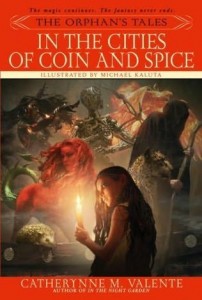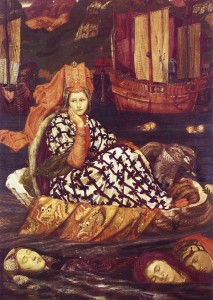 What follows is the second of two posts about Catherynne M. Valente’s duology, The Orphan’s Tales, wherein I discuss her style. Valente’s earliest published work was poetry, followed by short novels that might have been considered prose-poetry, given their density of language, and then came The Orphan’s Tales, which demonstrate a poet’s use of language. In the Cities of Coin and Spice (Bantam Spectra, 2007; all quotations are taken from this text), the second volume of that duology, intrigued me with its two types of style: poetic (particularly her choices of diction and syntax) and allusive. Warning: Spoilers to follow.
What follows is the second of two posts about Catherynne M. Valente’s duology, The Orphan’s Tales, wherein I discuss her style. Valente’s earliest published work was poetry, followed by short novels that might have been considered prose-poetry, given their density of language, and then came The Orphan’s Tales, which demonstrate a poet’s use of language. In the Cities of Coin and Spice (Bantam Spectra, 2007; all quotations are taken from this text), the second volume of that duology, intrigued me with its two types of style: poetic (particularly her choices of diction and syntax) and allusive. Warning: Spoilers to follow.
To begin, Valente’s allusive style draws heavily on allusions to familiar fairy tales, which felt more evident in In the Cities of Coin and Spice (at least in the first half of that novel) than in the first book, In the Night Garden. In other words, I recognized her source material in the second volume of this duology more than I did in the first. This allusive style consists of both her re-imaginings of European fairy tales as well as her use of particular stylistic devices found in those fairy tales.
The stylistic device Valente draws on from fairy tales is primarily repetition, usually in sets of threes, which is a standard fairy tale element (tales frequently involve three daughters or three sons, or completing three tasks, or locating three objects, etc.). For example, in “The Soldier’s Tale,” military recruiters come to a father three times, to enlist first his two sons and then his daughter (the narrator of the tale). Each child wants to go, and each time the father says, “Kin may not be denied” (56). After each visit from the recruiter, the narrator learns a new word: “I learned the word mercenary from this man” (56), “I learned the word impressments from this man” (57), and “I learned the word attrition from this man” (57). Another example comes from “The Tale of the Blue Serpent,” in which the narrator’s lamia-mothers say three times, “Do not go to the river’s mouth. It will gobble you up, and then where will you be?” (345).
Additionally, Valente re-imagines several European fairy tales to good effect in the novel. The first reference is to “The Frog Prince,” found in Valente’s “The Huldra’s Tale.” In the original Brothers Grimm version, a princess loses her golden ball down a well, and a frog retrieves it for her, but with a request that she keep him as a companion. In Valente’s version, Oubliette, who is a huldra (a mix of girl, tree, and cow), is given a golden ball by her mother; the golden ball turns out to be a hedgehog, who—with the help of other hedgehogs—encases Oubliette in a “house” and intends to keep her as his wife. The elements that Valente maintains—the girl with a golden ball, the animal longing for companionship—are given a more aggressive twist. The second allusion is to another Brothers Grimm tale, “Mother Holle,” in which a good sister is rewarded for her good behavior by the titular Mother Holle by having diamonds fall from her mouth whenever she speaks; the wicked sister, for her rudeness, is cursed to drop toads and snakes from her mouth. Valente twists the tale in her “Poisoner’s Tale,” wherein the “good” sister (who is unfailingly pious and proud of it, and consequently no fun at all) is made to drop frogs from her mouth and the “bad” sister (whose crime is liking to dance and have fun) drops pearls, both by means of fantastical poison. The poisoner tells the king, who wanted his daughters taught a lesson:
From the mouth of the child you judged wicked comes nothing but cold stones, lifeless, shellfish waste. In a seaside kingdom such as yours, they are too common to be called valuable. Beautiful, yes, and they have their worth, but they are just pretty rocks. Out of the other comes frogs, which you may consider ugly, but are food and clothing and curatives and poisons. They are eminently useful creatures in any clime, and she will never be hungry, nor anyone who comes near. Yet those who come near will as often as not cry out in disgust and speak not to her sweetness. Tell me I have not taught a lesson they will remember! (88)
Valente keeps the moral-based nature of the Grimms’ original tale but twists it. As it turns out, the reader sees that the daughters do not learn the lessons intended; the “good” sister sets up a shrine to her frogs, while the “bad” sister leaves the seaside kingdom and uses the pearls to pay her way (and her friends’ ways) through the world. The third allusion is likewise to a Brothers Grimm tale, “Brother and Sister,” wherein a sister warns her brother from drinking at three enchanted springs because a drink from the first will turn him into a tiger, from the second a wolf, and from the third a deer. The brother is so thirsty that he cannot resist the third spring, and thus is turned permanently into a deer. Valente keeps the basic structure in “The Pig Tamer’s Tale,” although it is a daughter who warns her father not to drink from rain-filled animal pawprints, the first set belonging to a leopard, the second to a tiger, and the third to a boar. As in the Grimms’ version, the father drinks from the third set of pawprints and is turned into a boar. Unlike the brother and sister, who live in an abandoned cottage until a king discovers them, the daughter and father in Valente’s tale become part of a traveling carnival where they have created an act around the dressing “in ribbons and hats” (146) of the boar-father because “folk don’t believe it’s a tamed beast if it doesn’t have the right costume. All tamed things are made a bit ridiculous in the process, you know” (146-147).
Valente also alludes to a couple of French fairy tales throughout In the Cities of Coin and Spice, in particular the story of Melusine, who was punished to be a serpent from the waist down, sometimes depicted with wings, every Saturday because she and her sisters had disrespected their father. But Melusine is very beautiful and she catches the eye of a king, whom she agrees to marry if he will let her keep Saturday to herself without his prying eyes. He keeps his promise for several years, but eventually jealousy or curiosity get the best of him and he peeks at Melusine in her Saturday bath, where he sees her serpent’s tail. Because he has broken his promise to her, Melusine flies out of the window and away, never to return. Valente’s use of the Melusine tale actually stretches across both books of The Orphan’s Tales, centering as it does around one of the fallen Stars (the equivalent of gods in the books), Zmeya, who is the Snake-Star, and whose tale is told several times in both books. She too asks for a weekly afternoon to herself (and later for their fourteen children), when she (and they) becomes serpentine, and her husband too breaks his promise not to spy. But instead of flying away, Zmeya and her children are killed by the king’s men, and then her body is served to them (her husband eats her heart). But revenge is to be had: Zmeya takes control of her portions of her body inside the men and forces them to kill each other. Valente here takes a known tale and puts another aggressive spin on it, where the woman is not simply a victim but also the agent of her own revenge.
The second style Valente employs in In the Cities of Coin and Spice is her poetic voice, to which I am drawn. Thinking about her style was particularly interesting to me in thinking about my own style, which people have described as “poetic.” Generally speaking, Valente uses mostly common words but she plays with the syntax of her sentences, taking a more artful—and, some might say, old-fashioned—approach, as in the sentence, “Who would ever notice such a little thing tucked away like that, in a city of pillars and plums and plumes?” (28). The alliteration (pillars plums plumes) and repetition of “and” is recognizable immediately, but I also appreciated her choices involve sounds and how “pillars” with its initial “p” and then “l” sounds leads smoothly into “plums” and “plumes” (and the play on those two words—close in spelling and sound). Another example is “The rest of him was all bones, great, long, yellow bones, and his skeleton was more than a man’s, for the thin fringe-frames of his huge wings arched up from his spine, the substance of his senescent hunch” (157). Valente plays with sentence convention in her use of the appositive “great, long, yellow bones,” which is set off from the “bones” it describes with only commas rather than a dash, which would interrupt the flow of the sentence, and the use of commas here lends itself to this sensuous description. She uses alliteration again in “fringe-frames” along with the repetition of sound in “his spine, the substance of his senescent hunch.”
I found this examination of Valente’s style to be instructive in two ways. First, she makes something fresh out of the fairy tales to which she alludes, which gives me further insight into how to be less literal in using my own source materials. Second, she sustains her beautifully crafted poetic style through almost a thousand pages of prose, and never does the poetic style overwhelm the narrative. In other words, a conscious style doesn’t have to detract from the story.





